交易费用与科斯定理
- 格式:ppt
- 大小:281.50 KB
- 文档页数:25
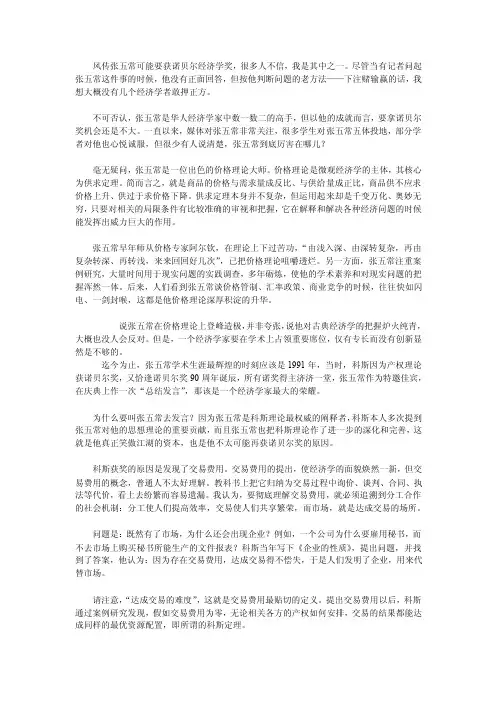
风传张五常可能要获诺贝尔经济学奖,很多人不信,我是其中之一。
尽管当有记者问起张五常这件事的时候,他没有正面回答,但按他判断问题的老方法——下注赌输赢的话,我想大概没有几个经济学者敢押正方。
不可否认,张五常是华人经济学家中数一数二的高手,但以他的成就而言,要拿诺贝尔奖机会还是不大。
一直以来,媒体对张五常非常关注,很多学生对张五常五体投地,部分学者对他也心悦诚服,但很少有人说清楚,张五常到底厉害在哪儿?毫无疑问,张五常是一位出色的价格理论大师。
价格理论是微观经济学的主体,其核心为供求定理。
简而言之,就是商品的价格与需求量成反比、与供给量成正比,商品供不应求价格上升、供过于求价格下降。
供求定理本身并不复杂,但运用起来却是千变万化、奥妙无穷,只要对相关的局限条件有比较准确的审视和把握,它在解释和解决各种经济问题的时候能发挥出威力巨大的作用。
张五常早年师从价格专家阿尔钦,在理论上下过苦功,“由浅入深、由深转复杂,再由复杂转深、再转浅,来来回回好几次”,已把价格理论咀嚼透烂。
另一方面,张五常注重案例研究,大量时间用于现实问题的实践调查,多年砺炼,使他的学术素养和对现实问题的把握浑然一体。
后来,人们看到张五常谈价格管制、汇率政策、商业竞争的时候,往往快如闪电、一剑封喉,这都是他价格理论深厚积淀的升华。
说张五常在价格理论上登峰造极,并非夸张,说他对古典经济学的把握炉火纯青,大概也没人会反对。
但是,一个经济学家要在学术上占领重要席位,仅有专长而没有创新显然是不够的。
迄今为止,张五常学术生涯最辉煌的时刻应该是1991年,当时,科斯因为产权理论获诺贝尔奖,又恰逢诺贝尔奖90周年诞辰,所有诺奖得主济济一堂,张五常作为特邀佳宾,在庆典上作一次“总结发言”,那该是一个经济学家最大的荣耀。
为什么要叫张五常去发言?因为张五常是科斯理论最权威的阐释者,科斯本人多次提到张五常对他的思想理论的重要贡献,而且张五常也把科斯理论作了进一步的深化和完善,这就是他真正笑傲江湖的资本,也是他不太可能再获诺贝尔奖的原因。
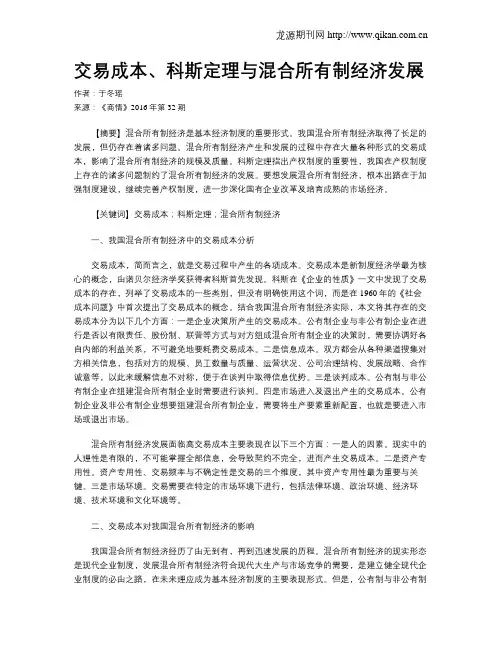
交易成本、科斯定理与混合所有制经济发展作者:于冬瑶来源:《商情》2016年第32期【摘要】混合所有制经济是基本经济制度的重要形式。
我国混合所有制经济取得了长足的发展,但仍存在着诸多问题。
混合所有制经济产生和发展的过程中存在大量各种形式的交易成本,影响了混合所有制经济的规模及质量。
科斯定理指出产权制度的重要性,我国在产权制度上存在的诸多问题制约了混合所有制经济的发展。
要想发展混合所有制经济,根本出路在于加强制度建设,继续完善产权制度,进一步深化国有企业改革及培育成熟的市场经济。
【关键词】交易成本;科斯定理;混合所有制经济一、我国混合所有制经济中的交易成本分析交易成本,简而言之,就是交易过程中产生的各项成本。
交易成本是新制度经济学最为核心的概念,由诺贝尔经济学奖获得者科斯首先发现。
科斯在《企业的性质》一文中发现了交易成本的存在,列举了交易成本的一些类别,但没有明确使用这个词,而是在1960年的《社会成本问题》中首次提出了交易成本的概念。
结合我国混合所有制经济实际,本文将其存在的交易成本分为以下几个方面:一是企业决策所产生的交易成本。
公有制企业与非公有制企业在进行是否以有限责任、股份制、联营等方式与对方组成混合所有制企业的决策时,需要协调好各自内部的利益关系,不可避免地要耗费交易成本。
二是信息成本。
双方都会从各种渠道搜集对方相关信息,包括对方的规模、员工数量与质量、运营状况、公司治理结构、发展战略、合作诚意等,以此来缓解信息不对称,便于在谈判中取得信息优势。
三是谈判成本。
公有制与非公有制企业在组建混合所有制企业时需要进行谈判。
四是市场进入及退出产生的交易成本。
公有制企业及非公有制企业想要组建混合所有制企业,需要将生产要素重新配置,也就是要进入市场或退出市场。
混合所有制经济发展面临高交易成本主要表现在以下三个方面:一是人的因素。
现实中的人理性是有限的,不可能掌握全部信息,会导致契约不完全,进而产生交易成本。
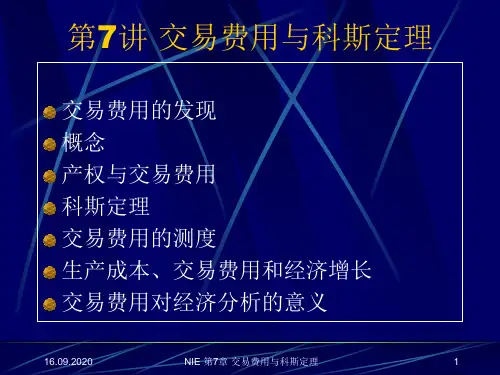
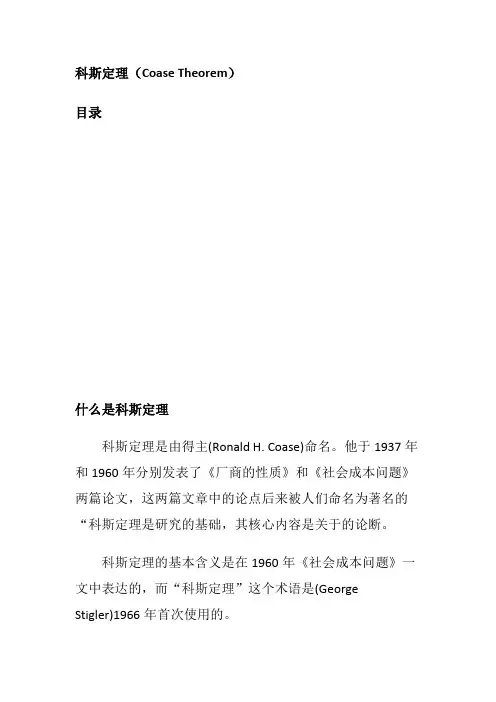
科斯定理(Coase Theorem)目录什么是科斯定理科斯定理是由得主(Ronald H. Coase)命名。
他于1937年和1960年分别发表了《厂商的性质》和《社会成本问题》两篇论文,这两篇文章中的论点后来被人们命名为著名的“科斯定理是研究的基础,其核心内容是关于的论断。
科斯定理的基本含义是在1960年《社会成本问题》一文中表达的,而“科斯定理”这个术语是(George Stigler)1966年首次使用的。
科斯定理较为通俗的解释是:“在为零和对产权充分界定并加以实施的条件下,因素不会引起资源的不当配置。
因为在此场合,当事人(外部性因素的生产者和)将受一种市场里的驱使去就互惠互利的交易进行谈判,也就是说,是外部性因素内部化。
”也有人认为科斯定理是由两个定理组成的。
即为史提格勒的表述:如果为零,不管权利初始安排如何,会自动使达到。
在大于零的现实世界,可以表述为:一旦考虑到市场交易的成本,合法权利的初始界定以及经济的选择将会对产生影响。
科斯定理的构成科斯定理由三组定理构成。
的内容是:如果为零,不管产权初始如何安排,当事人之间的谈判都会导致那些财富最大化的安排,即会自动达到。
如果科斯第一定理成立,那么它所揭示的经济现象就是:在大千世界中,任何经济活动的效益总是最好的,任何工作的效率都是最高的,任何原始形成的安排总是最有效的,因为任何交易的费用都是零,人们自然会在内在利益的驱动下,自动实现的最优配置,因而,没有必要存在,更谈不上产权制度的优劣。
然而,这种情况在现实生活中几乎是不存在的,在经济社会一切领域和一切活动中,交易费用总是以各种各样的方式存在,因而,是建立在绝对虚构的世界中,但它的出现为科斯第二定理作了一个重要的铺垫。
通常被称为科斯定理的反定理,其基本含义是:在交易费用大于零的世界里,不同的权利界定,会带来不同效率的资源配置。
也就是说,交易是有成本的,在不同的下,交易的成本可能是不同的,因而,资源配置的效率可能也不同,所以,为了优化资源配置,产权制度的选择是必要的。
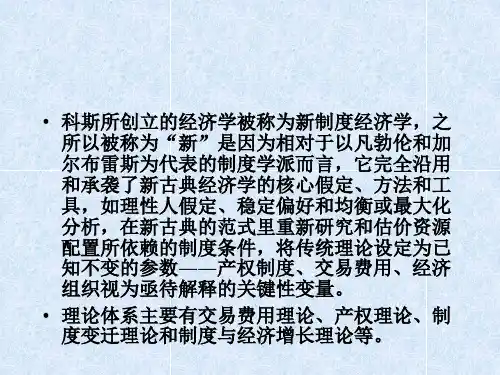
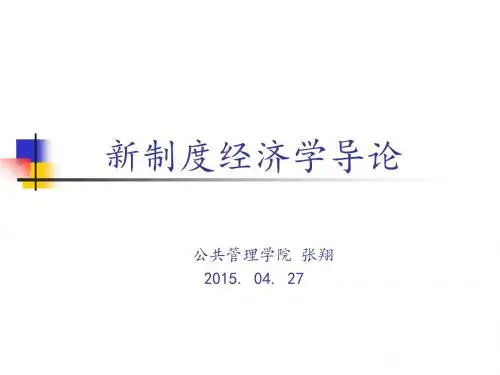

第二讲交易费用理论与科斯定理第二讲交易费用理论与科斯定理(2课时)教学重点与难点:本章主要阐述作为新制度经济学基础理论的交易费用理论与科斯定理,通过学习,要准确理解交易费用和科斯定理的涵义,掌握新制度经济学最基本的范畴和分析工具。
第二讲交易费用理论与科斯定理(2课时)教学重点与难点:本章主要阐述作为新制度经济学基础理论的交易费用理论与科斯定理,通过学习,要准确理解交易费用和科斯定理的涵义,掌握新制度经济学最基本的范畴和分析工具。
第一节交易费用理论的基本内容[问题与思考]一家汽车制造厂自己不生产汽车轮胎,轮胎由另一家厂商专门生产,两个厂发生的交易行为是企业外的市场行为,两家企业会发生订货供货的买卖行为,所遵循的是价格机制或市场供求规律,通过讨价还价最后形成均衡价格与均衡数量,这种在交易中的成本或费用肯定是存在的。
问题:汽车制造厂在什么情况下会考虑兼并轮胎厂,将其变成自己的一个分厂或车间?一、交易费用的涵义交易费用概念是由科斯创立的。
他在1937年发表的《企业的性质》一文,标志着交易费用范畴的创立和交易费用理论的初步形成。
之后,该理论迅速发展,其中,威廉姆森的贡献最大。
1、科斯以前的交易理论(1)亚里士多德对交易的论述商业交易;贷钱交易;雇佣交易。
从事这三种交易活动都可以带来财富或致富。
他提出了交易的概念,并将交易与生产区被开来,为后来的经济学家所肯定。
(2)康芒斯对交易的论述在1934年出版的《制度经济学》一书中,他以法律的观点来解释社会经济关系,认为经济关系的本质是交易,整个社会是由无数种交易组成的一种有机的组织。
康芒斯的交易是在一定的秩序或集体行动中的规则中发生的、在利益彼此冲突的个人之间的所有权的转移。
他将交易的具体类型分为三种:第一,买卖的交易,即法律上平等和自由的人们之间自愿的买卖关系。
其一般原则是稀少性。
第二,管理的交易,是一种以财富的生产为目的的交易。
其一般的原则是效率。
第三,限额的交易,是一种上级对下级的关系。
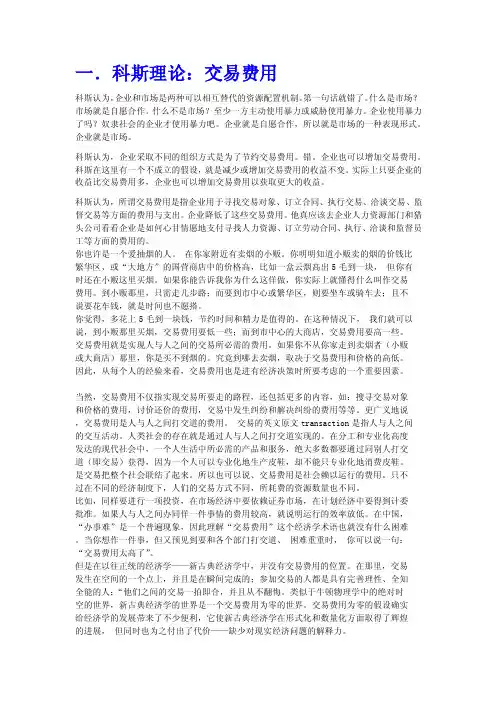
一.科斯理论:交易费用科斯认为,企业和市场是两种可以相互替代的资源配置机制。
第一句话就错了。
什么是市场?市场就是自愿合作。
什么不是市场?至少一方主动使用暴力或威胁使用暴力。
企业使用暴力了吗?奴隶社会的企业才使用暴力吧。
企业就是自愿合作,所以就是市场的一种表现形式。
企业就是市场。
科斯认为,企业采取不同的组织方式是为了节约交易费用。
错。
企业也可以增加交易费用。
科斯在这里有一个不成立的假设,就是减少或增加交易费用的收益不变。
实际上只要企业的收益比交易费用多,企业也可以增加交易费用以获取更大的收益。
科斯认为,所谓交易费用是指企业用于寻找交易对象、订立合同、执行交易、洽谈交易、监督交易等方面的费用与支出。
企业降低了这些交易费用。
他真应该去企业人力资源部门和猎头公司看看企业是如何心甘情愿地支付寻找人力资源、订立劳动合同、执行、洽谈和监督员工等方面的费用的。
你也许是一个爱抽烟的人。
在你家附近有卖烟的小贩。
你明明知道小贩卖的烟的价钱比繁华区、或“大地方”的国营商店中的价格高,比如一盒云烟高出5毛到一块,但你有时还在小贩这里买烟。
如果你能告诉我你为什么这佯做,你实际上就懂得什么叫作交易费用。
到小贩那里,只需走几步路;而要到市中心或繁华区,则要坐车或骑车去;且不说要花车钱,就是时间也不愿搭。
你觉得,多花上5毛到一块钱,节约时间和精力是值得的。
在这种情况下,我们就可以说,到小贩那里买烟,交易费用要低一些;而到市中心的大商店,交易费用要高一些。
交易费用就是实现人与人之间的交易所必需的费用。
如果你不从你家走到卖烟者(小贩或大商店)那里,你是买不到烟的。
究竟到哪去卖烟,取决于交易费用和价格的高低。
因此,从每个人的经验来看,交易费用也是进有经济决策时所要考虑的一个重要因素。
当然,交易费用不仅指实现交易所要走的路程,还包括更多的内容,如:搜寻交易对象和价格的费用,讨价还价的费用,交易中发生纠纷和解决纠纷的费用等等。
更广义地说,交易费用是人与人之间打交道的费用。
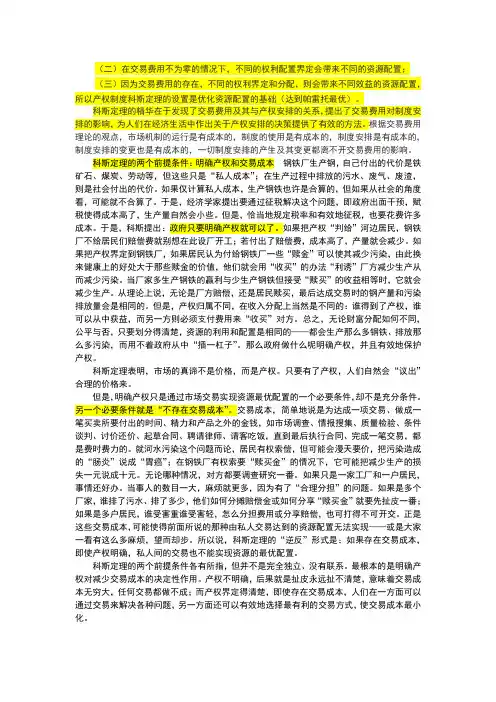
(二)在交易费用不为零的情况下,不同的权利配置界定会带来不同的资源配置;(三)因为交易费用的存在,不同的权利界定和分配,则会带来不同效益的资源配置,所以产权制度科斯定理的设置是优化资源配置的基础(达到帕雷托最优)。
科斯定理的精华在于发现了交易费用及其与产权安排的关系,提出了交易费用对制度安排的影响,为人们在经济生活中作出关于产权安排的决策提供了有效的方法。
根据交易费用理论的观点,市场机制的运行是有成本的,制度的使用是有成本的,制度安排是有成本的,制度安排的变更也是有成本的,一切制度安排的产生及其变更都离不开交易费用的影响。
科斯定理的两个前提条件:明确产权和交易成本钢铁厂生产钢,自己付出的代价是铁矿石、煤炭、劳动等,但这些只是“私人成本”;在生产过程中排放的污水、废气、废渣,则是社会付出的代价。
如果仅计算私人成本,生产钢铁也许是合算的,但如果从社会的角度看,可能就不合算了。
于是,经济学家提出要通过征税解决这个问题,即政府出面干预,赋税使得成本高了,生产量自然会小些。
但是,恰当地规定税率和有效地征税,也要花费许多成本。
于是,科斯提出:政府只要明确产权就可以了。
如果把产权“判给”河边居民,钢铁厂不给居民们赔偿费就别想在此设厂开工;若付出了赔偿费,成本高了,产量就会减少。
如果把产权界定到钢铁厂,如果居民认为付给钢铁厂一些“赎金”可以使其减少污染,由此换来健康上的好处大于那些赎金的价值,他们就会用“收买”的办法“利诱”厂方减少生产从而减少污染。
当厂家多生产钢铁的赢利与少生产钢铁但接受“赎买”的收益相等时,它就会减少生产。
从理论上说,无论是厂方赔偿,还是居民赎买,最后达成交易时的钢产量和污染排放量会是相同的。
但是,产权归属不同,在收入分配上当然是不同的:谁得到了产权,谁可以从中获益,而另一方则必须支付费用来“收买”对方。
总之,无论财富分配如何不同,公平与否,只要划分得清楚,资源的利用和配置是相同的——都会生产那么多钢铁、排放那么多污染,而用不着政府从中“插一杠子”。
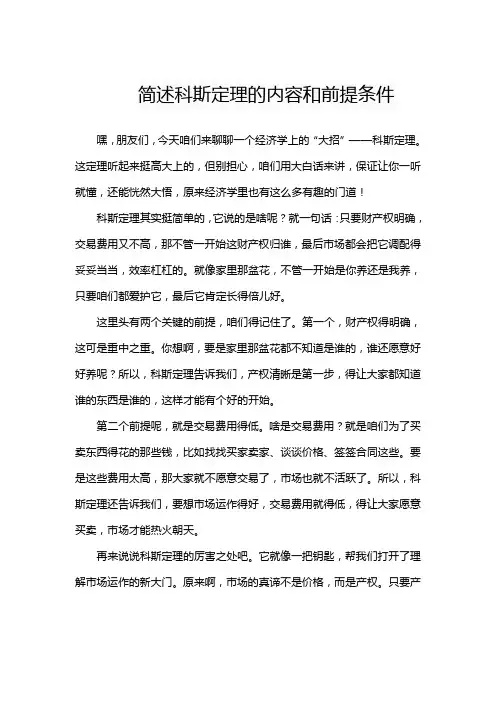
简述科斯定理的内容和前提条件嘿,朋友们,今天咱们来聊聊一个经济学上的“大招”——科斯定理。
这定理听起来挺高大上的,但别担心,咱们用大白话来讲,保证让你一听就懂,还能恍然大悟,原来经济学里也有这么多有趣的门道!科斯定理其实挺简单的,它说的是啥呢?就一句话:只要财产权明确,交易费用又不高,那不管一开始这财产权归谁,最后市场都会把它调配得妥妥当当,效率杠杠的。
就像家里那盆花,不管一开始是你养还是我养,只要咱们都爱护它,最后它肯定长得倍儿好。
这里头有两个关键的前提,咱们得记住了。
第一个,财产权得明确,这可是重中之重。
你想啊,要是家里那盆花都不知道是谁的,谁还愿意好好养呢?所以,科斯定理告诉我们,产权清晰是第一步,得让大家都知道谁的东西是谁的,这样才能有个好的开始。
第二个前提呢,就是交易费用得低。
啥是交易费用?就是咱们为了买卖东西得花的那些钱,比如找找买家卖家、谈谈价格、签签合同这些。
要是这些费用太高,那大家就不愿意交易了,市场也就不活跃了。
所以,科斯定理还告诉我们,要想市场运作得好,交易费用就得低,得让大家愿意买卖,市场才能热火朝天。
再来说说科斯定理的厉害之处吧。
它就像一把钥匙,帮我们打开了理解市场运作的新大门。
原来啊,市场的真谛不是价格,而是产权。
只要产权明确了,大家自然会商量出一个合理的价格来。
这样一来,政府也就不必老是插手干预了,市场自己能解决问题,多省心啊!当然了,科斯定理也不是万能的。
在现实世界里,产权明确和交易费用低这两个条件可不容易满足。
但即便如此,科斯定理还是给我们提供了一个新的思路和方法,让我们在面对市场问题时能多一份从容和智慧。
怎么样,听了我的讲解,你是不是也对科斯定理有了个初步的认识呢?下次和朋友聊天时,不妨也显摆显摆,让他们也对你刮目相看哦!。

TRANSACTION COSTS AND THE ROBUSTNESS OF THECOASE THEOREM*Luca Anderlini and Leonardo FelliThis paper explores the extent to which ex ante transaction costs may lead to failures of the Coase Theorem.In particular we identify the basic Ôhold-up problem Õthat arises whenever the parties to a Coasian negotiation have to pay ex ante costs for the negotiation to take place.We then show that a ÔCoasian solution Õto this problem is not available:a Coasian solution typically entails a negotiation about the payment of the costs associated with the future negotiation,which in turn is associated with a fresh set of ex ante costs,and hence a new hold-up problem.The Coase theorem (Coase,1960)has had a profound influence on the way economists and legal scholars think about inefficiencies .It guarantees that provided that property rights are allocated,fully informed rational agents involved in an inefficient situation will ensure through negotiation that there are no unexploited gains from trade and hence an efficient outcome obtains.In its strongest formulation,the Coase theorem is interpreted as guaranteeing an efficient outcome regardless of the Ôway in which property rights are assigned Õ(Nicholson,1989,p.725)and whenever the potential mutual gains Ôexceed [the]necessary bargaining costs Õ(Nicholson,1989,p.726).1The predictions entailed by the stronger version of the Coase theorem are startling.Whenever property rights are allocated,we should observe only outcomes that are constrained efficient in the sense that all potential gains from trade (net of transaction costs)are exploited.This clearly contradicts even the most casual observation of empirical facts.There are many obvious instances of situations in which Pareto improving negotiation opportunities are available,but are left unexploited by the parties involved.2If we were to believe the predictions of the Ôstrong ÕCoase theorem,all these apparent inefficiencies would not be real inefficiencies at all.They should simply *We are grateful to one of the Editors of this J ournal ,David de Meza,and to two anonymous referees for extremely useful feedback.An early version of this paper was circulated as a working paper entitled ÔCostly Coasian Contracts Õ(Anderlini and Felli,1998).Revisions and further work were com-pleted while Leonardo Felli was visiting the Department of Economics at the University of Pennsylvania and the Department of Economics of the Stern School of Business at NYU.Their generous hospitality is gratefully acknowledged.Both authors thank the ESRC (Grant R000237825)for financial support.We are also grateful to Ian Gale and to seminar participants at the ISER 2000in Siena for stimulating comments.This paper was submitted before Leonardo Felli was invited to become an editor of the Journal and accepted for publication by the previous editorial board.1This stronger version of the Coase theorem does not correspond to what is claimed in Coase (1960),but it is an interpretation of it that is sufficiently common to have found its way into basic micro-economic text-books such as the one quoted above.2Of course,we are not claiming that these observed inefficiencies can necessarily be traced to the sources we identify in our analysis below.In many cases a simple appeal to Ôirrational expectations Õsuffices to explain observed failures to exploit potential gains from trade.See our discussion of some anecdotal evidence that we believe fits our model well in Section 2below.The Economic Journal ,116(January ),223–245.ÓRoyal Economic Society 2006.Published by Blackwell Publishing,9600Garsington Road,Oxford OX42DQ,UK and 350Main Street,Malden,MA 02148,USA.[223]be viewed as the result of transaction costs that are Ôhigh Õrelative to the potential gains from trade.We take the view that this is not a satisfactory explanation of these observed facts.Our aim in this article is to take issue with this strong version of the Coase theorem and show that the impact of transaction costs can extend over and above their size relative to the potential gains from trade.This stems from the strategic role that transaction costs may play in a Coasian negotiation.It turns out that a key factor in determining the strategic role of transaction costs is whether they are payable ex ante or ex post ;after the negotiation concerning the distribution of the unexploited gains from trade takes place.We show that in the presence of ex ante transaction costs a constrained inefficient outcome may obtain.In Anderlini and Felli (2001a )(henceforth AF)we introduce ex ante costs in each round of an alternating offers bargaining model (Rubinstein,1982).In each period,both the proposer and the responder must pay a cost for the negotiation to proceed.If either player declines to pay,the current round of offer and response is cancelled and play moves on to the next round.In that article we show that it is always an equilibrium for both players never to pay the ex ante costs and hence never to agree on a division of the potential surplus,although the sum of the ex ante costs is strictly lower than the surplus itself.Moreover,we show that this is the unique equilibrium outcome in both the fol-lowing cases:(1)If the sum of the ex ante costs is not Ôtoo low Õ(but still less than the availablesurplus)and/or the distribution of these costs across the players is suffi-ciently asymmetric,and(2)If we impose that the equilibrium must be robust to the possibility that theplayers might find a way to renegotiate out of future inefficiencies.3Thus,in AF we show that when the distribution of surplus across contracting parties is endogenous (it is the outcome of the bargaining –if it ever takes place),transaction costs that are payable ex ante can have a devastating effect on efficiency.In this article,we take it as given that if the negotiating stage is reached an agreement will result and,for simplicity,we take as (parametrically)given the parties Õshares of surplus in this agreement.We then introduce transaction costs that are payable ex ante :the negotiation stage is reached only if these costs are paid.We find that for some combinations of bargaining power (determining surplus shares)and ex ante costs adding up to less than the available surplus,no agreement will take place because the costs will not be paid.A natural further question follows at this point.Suppose that we allow the parties to negotiate some compensating transfers before the ex ante costs are payable.In3In AF we actually propose a modification of the extensive form that is meant to capture the requirement of renegotiation-proofness.This is because,there,we take the view that Ôblack-box Õrene-gotiation is not an appropriate modelling ingredient in a model of the actual negotiation between players.224[J A N U A R Y T H E E C O N O M I C J O U R N A L ÓRoyal Economic Society 2006other words,suppose that we endow the parties with the possibility of undoing the effects of the ex ante transaction costs in a Coasian way ahead of time.Is it then the case that the inefficiencies we found will disappear?The answer we obtain is Ôno Õ,provided that the negotiation of the compensating transfers is itself associated with a fresh set of ex ante transaction costs,regardless of how small these new costs are .Proceeding with a simple stripped-down model of the negotiating phase (in essence a single parameter between 0and 1)has a two-fold advantage.First of all,it safely allows us to abstract from the problem analysed in AF,so that we know that the efficiency failures that we find here come from a different source than the one pinpointed there.Secondly,it allows us to check the robustness of our results to some basic changes in the way ex ante costs are payable,keeping the analysis at a very tractable level.In particular,below we show that our results are Ôpervasive Õin the sense that they survive when it is enough that one party pays,and when the ex ante costs are modelled as Ôstrategic complements Õ.We begin our analysis with a brief review of the related literature (Section 1)and a discussion of the possible interpretations of the ex ante transaction costs (Section2).We then proceed in Section 3to present the simplest possible model of the basic hold-up problem associated with a surplus-enhancing negotiation.This problem is analysed in the case in which the ex ante costs associated with the Coasian negotiation are either complements or substitutes.In Section 4we address the question of whether a Coasian solution to our basic hold-up problem is plausible.We do this by analysing the possibility of a negotiated transfer from one party to the other before the payment of the transaction costs that are at the origin of the hold-up problem.In Section 5we look at how the allocation of property rights may or may not alleviate the inefficiencies stemming from ex ante transaction costs.Section 6offers some concluding remarks.To ease the exposition,we have relegated all proofs to the Appendix.1.Related LiteratureWhat has become known as the Coase theorem (Coase,1960)assumes the absence of transaction costs or other frictions in the bargaining process.Coase (1960)himself does provide an extensive discussion of the role of transaction costs.4Indeed,Coase (1992)describes the result as provocative and intended to show how unrealistic is the world without transaction costs.Here and in AF,we go further by identifying the strategic role played by ex ante transaction costs (as opposed,for instance,to transaction costs that are payable ex post )which may lead to an outcome that is constrained inefficient .The source of inefficiencies in this article is a version of the Ôhold-up problem Õ(Grout,1984;Grossman and Hart,1986;Hart and Moore,1988,among many others).The problem is particularly acute in our setting since it may be impossible for the negotiating parties to find a ÔCoasian solution Õto this hold-up problem.Closely linked to the literature on the hold-up problem is the literature on the4de Meza (1988)provides an extensive survey of the literature on the Coase theorem,including an outline of its history and possible interpretations.2006]225T R A N S A C T I O N C O S T S A N D T H E C O A S E T H E O R E M ÓRoyal Economic Society 2006effects of the allocation of property rights when contracts are incomplete (Grossman and Hart,1986;Hart and Moore,1990;Chiu,1998;de Meza and Lockwood,1998;Rajan and Zingales,1998,among many others).It turns out that the effects of the allocation of property rights on the version of the hold-up problem we analyse here depends on how the parties Õoutside options affect the division of surplus.We devote Section 5below entirely to this point.We are certainly not the first to point out that the Coase theorem no longer holds when there are frictions in the negotiation process.There is a vast literature on bargaining models where the frictions take the form of incomplete and asymmetric information.With incomplete information,efficient agreements often cannot be reached and delays in bargaining may obtain.5By contrast,the reduced form negotiation that we consider in our analysis is one of complete information.The source of inefficiencies in this article can therefore be traced directly to the presence of transaction costs.Dixit and Olson (2000)are concerned with a classical Coasian public good problem in which they explicitly model the agents Õex ante (possibly costly)decisions of whether to participate or not in the bargaining process.In their setting they find both efficient and inefficient equilibria as opposed to the unique constrained inefficient equilibrium we derive in our setting.They also highlight the inefficiency of the symmetric (mixed-strategy)equilibria of their model.2.Ex Ante Transaction CostsWe are concerned with Coasian negotiations in which the parties have to incur some ex ante transaction costs,before they reach the stage in which the actual negotiation occurs.The interpretation of these ex ante transaction costs which we favour is that of time spent Ôpreparing Õfor the Coasian negotiation.Typically,a variety of tasks need to be carried out by the parties involved before the actual negotiation begins.In those cases in which the negotiation of an agreement contingent on a state of nature is concerned,both parties need to conceive of,and agree upon,a suitable language to describe the possible realisations of the state of nature precisely.The parties also need to collect and analyse information about the Ôlegal environment Õin which the agreement will be embedded.For instance,in different countries the same agreement will need to be drawn-up differently to make it legally enforce-able.In virtually all settings in which a negotiation is required,the parties need to spend time arranging a way to Ômeet Õand they need to Ôearmark Õsome of their time schedules for the actual meeting.In many cases,before a meaningful negotiation can start,the parties will need to collect and analyse background information that may be relevant to their under-standing of the actual trading opportunities.These activities may range from5See Muthoo (1999)for an up-to-date coverage as well as extensive references on this strand of literature and other issues in bargaining theory.226[J A N U A R Y T H E E C O N O M I C J O U R N A L ÓRoyal Economic Society 2006collecting information about (for instance the creditworthiness of)the other party,to actual Ôthinking Õor Ôcomplexity Õcosts incurred to understand the nego-tiation problem.We view this type of ex ante transaction costs as both relevant and important for the type of effects which we identify in our analysis below.However,it should be emphasised that our model does not directly apply to this type of costs.This is because in our model the size of the gains from trade is fixed and known to the parties.On the other hand,the lack of information and/or understanding of the negotiation setting that we have just described,would clearly make the size of the surplus uncertain for the parties involved.We have not considered the case of uncertain surplus for reasons of space and analytical convenience.However,we conjecture that the general flavour of our results generalises to this case.Where does one look for evidence of transactions that never took place because of ex ante costs?This is obviously no easy endeavour,aside perhaps from small things like not inspecting a used car because the negotiation can only take place after sinking the cost of travelling to where the car is kept.There is a well known colourful story –an anecdotal piece of evidence –that,in our view,fits the bill well enough to be mentioned here.6In 1980,IBM (then the unchallenged dominant player in the computer industry)decided to enter the market for Personal Computers.IBM did not have an operating sys-tem for PCs.To acquire an operating system from an outside source they sent a delegation to visit the offices of Microsoft to negotiate.At the time,however,Microsoft did not own an operating system either,and so they referred the visitors from IBM to a small company –Intergalactic Digital Research –that had a working operating system for PCs.The surprise match between IBM and Digital Research never reached the actual negotiation stage.The founder of Digital Research (Gary Kildall)refused to meet with the IBM delegation be-cause he had Ôother plans Õ.His wife (Dorothy Kildall)met with the represent-atives of IBM but refused their request to sign a non-disclosure agreement.Eventually,the IBM representatives left without any negotiation concerning the actual deal having taken place.The interpretation of events in line with our main point in this paper is clear.If the negotiating stage had been reached,IBM’s bargaining power would have been extreme.As a result Digital Research did not pay the ex ante costs necessary to reach the actual negotiation stage:Gary Kildall decided that his time was better employed elsewhere and Dorothy Kildall was put off by the non-disclosure agreement,a likely signal of the length and complexity of the negotiation to come,as well as a possible direct liability.The inefficiency of the outcome reached is6The story was the subject of a documentary series aired in 1996by PBS television stations in the US.The documentary was entitled Triumph of the Nerds:The Rise of Accidental Empires.The transcripts can be found at /nerds/.The documentary series was in turn based on Cringely (1992).The basic facts summarised here seem to be reasonably uncontroversial.However,it should also be pointed out that the story is so widely known that differing interpretations and versions of some of its details can be found in copious amounts on the World Wide Web.These include disputed accounts of a subsequent meeting between Gary Kildall of Digital Research and IBM.If this meeting did take place,clearly it did not generate an operative deal.Of course,the interpretation of the facts that we give is our own.2006]227T R A N S A C T I O N C O S T S A N D T H E C O A S E T H E O R E M ÓRoyal Economic Society 2006apparent:ownership of the dominant operating system for PCs turned out to be worth tens of billions of dollars in the following two decades alone.7We conclude this Section with an observation.In many cases the parties to a negotiation will have the opportunity to delegate to outsiders many of the tasks that we have mentioned as sources of ex ante transaction costs.The most common example of this is the hiring of lawyers.Abstracting from agency problems (be-tween the negotiating party/principal and the lawyer/agent),which are likely to increase the ex ante costs anyway,our analysis applies,unchanged,to the case in which the ex ante transaction costs that we have described are payable to an agent.3.The Basic Hold-up ProblemWe focus on three basic cases in which the presence of ex ante transaction costs generates the hold-up problem we have outlined informally above.The three cases we pursue in detail are chosen with a two-fold objective in mind.First of all they are the simplest models that suffice to put across the main point.Second,the range of cases they cover is meant to convey the fact that the ineffi-ciency we find is Ôpervasive Õin the sense that it obtains in a whole variety of extensive forms.In Anderlini and Felli (2001b )we show that the basic hold-up problem identified here survives when we allow transaction costs to be continuous as opposed to the binary choice considered here.3.1.Perfect ComplementsConsider two agents,called A and B ,who face a ÔCoasian Õopportunity to realise some gains from trade.Without loss of generality we normalise to one the size of the surplus realised if an agreement is reached.We also set the parties Õpayoffs in the case of disagreement to be equal to zero.In the first two cases we look at,once the negotiating phase is reached the division of surplus between the two agents is exogenously given and cannot be changed by the agents.8Let k 2[0,1]be the share of the surplus that accrues to agent A if the parties engage in the negotiation and 1Àk the share of the surplus that accrues to B .For the negotiation to start,each agent has to pay a given ex ante transaction cost .In other words,the agents reach the negotiating phase only if they both pay a7The enormity of the value of the missed transaction raises an obvious question:were Digital Re-search simply Ôdumb Õas some of the characters involved seem to suggest in the transcripts of the documentary cited above?(see footnote 6).Our reply is two-fold.First,the value of the failed trans-action was surely highly uncertain at the time.To measure it with its realised value more than 20years later does not seem correct.Second,the realised value of the failed transaction is measured by the subsequent success of Microsoft.However,while Microsoft did supply IBM with an operating system for PCs soon after the events we have described,they did not sell it,but rather they licensed it to IBM.Microsoft concluded a deal with IBM using a contractual device that,as it turns out,shifted the division of surplus dramatically in its favour.8See our introduction for a discussion of AF where the division of surplus is endogenously deter-mined by the model.228[J A N U A R Y T H E E C O N O M I C J O U R N A L ÓRoyal Economic Society 2006certain amount before the negotiation begins.9These costs should be thought of as representing a combination of the activities necessary for the gains from trade to materialise which we discussed in some detail in Section 2.Let c A >0and c B >0be the two agents Õex ante costs.Clearly,if c A þc B >1then the two agents will never reach the negotiation stage that yields the unit surplus.Clearly,neither would a social planner since the total cost of the negotiation exceeds the surplus which it yields.We are interested in the case in which it would be socially efficient for the two agents to negotiate an agreement.Our first assumption guarantees that this is the case.Assumption 1:The surplus that the negotiation yields exceeds the total ex ante costs that are payable for the negotiation to occur.In other words c A þc B <1.Our two agents play a two-stage game.In period t ¼0they both simultaneously and independently decide whether to pay their ex ante cost.An agreement yielding a surplus of size one at t ¼1is feasible only if both agents pay their ex ante costs at t ¼0.10The game at t ¼1is a simple Ôblack box Õ,yielding payoffs of k to A and 1Àk to B .If one or both agents do not pay their ex ante costs at t ¼0,the game at t ¼1is trivial:the negotiation that yields the unit surplus is not feasible;the agents have no actions to take and they both receive a payoff of zero.Throughout the article,unless otherwise stated,by equilibrium we mean a subgame perfect equilibrium of the game at hand.The normal form that corres-ponds to the two-stage game we have just described is depicted in Figure 1.From this it is immediate to derive our first Proposition,which therefore is stated without proof.Proposition 1:If either c A >k or c B >1Àk the unique equilibrium of the two-stage game represented in Figure 1has neither agent paying the ex ante cost and therefore yields the no-agreement outcome.We view Proposition 1as implying that in the presence of ex ante transaction costs,if the distribution of ex ante costs across the parties is sufficiently Ômis-matched Õwith the distribution of surplus,then the ex ante costs will generate a version of the hold-up problem which will induce the agents not to negotiate an agreement even though it would be socially efficient to do so.9Notice therefore that we are implicitly assuming that the agents have some endowments of resources out of which the ex ante costs can be paid.10Notice that we are therefore assuming that the two agents Õex ante costs are perfect complements in the Ôtechnology Õthat determines whether the surplus-generating negotiation is feasible or not.We examine the cases of perfect substitutes,and of strategic complements in Subsections 3.2and 3.3below respectively.2006]229T R A N S A C T I O N C O S T S A N D T H E C O A S E T H E O R E M ÓRoyal Economic Society 2006The intuition behind Proposition 1is simple enough.If negotiating an agree-ment involves some costs that are payable ex ante ,the share of the surplus accruing to each party will not depend,in equilibrium,on whether the ex ante costs are paid.Therefore,the parties will pay the costs only if the distribution of the surplus generated by the negotiation will allow them to recoup the cost ex post .If the distribution of surplus and that of ex ante costs are sufficiently Ômis-matched Õ,then one of the agents will not be able to recoup the ex ante cost.In this case,an agreement will not be reached,even though it would generate a total surplus large enough to cover the ex ante costs of both agents.As a polar benchmark,consider the alternative setup in which both parties can pay the costs c A and c B after the negotiation has occurred and an agreement is reached.In other words the transaction costs can be paid ex post rather than ex ante .11In this case the extensive form of the game is equivalent to a simple negotiation in which the size of the gains from trade is 1Àc A Àc B .The assumption we made on the black-box negotiation implies that in this case the two parties do indeed reach an agreement.Party A receives the share of surplus k (1Àc A Àc B )while party B receives the share (1Àk )(1Àc A Àc B ).In other words when transaction costs can be paid ex post the strong version of the Coase Theorem holds and a constrained efficient outcome is guaranteed.We conclude this subsection with two observations.First of all,the simultaneity in the payment of the ex ante costs is not essential to Proposition 1.The result applies to the case in which the ex ante costs are payable sequentially by the two agents before the actual negotiation begins.Second,while the model has a unique equilibrium for the parameter configu-rations identified in Proposition 1,it has multiple equilibria whenever this pro-position does not apply.It is clear that,whenever both k >c A and (1Àk )>c B ,the model has two equilibria.One in which the ex ante costs are paid and an agreement is reached,and another in which neither agent pays the ex ante costs simply because he expects the other agent not to pay his cost either.The equi-librium in which the agreement is reached strictly Pareto-dominates the no-agreement equilibrium.Clearly,the multiplicity of equilibria disappears if the costs are payable sequentially.The latter observation will become relevant again in Section 4below.3.2.Perfect SubstitutesWe now turn to our second simple model.The next Proposition tells us that when the agents Õex ante costs are perfect substitutes our constrained inefficiency result of Subsection 3.1still holds,although the inefficiency may take a different form.The intuition behind the next results is straightforward.In an environment in which the ex ante costs may be paid by either agent the negotiation leads to a constrained efficient outcome if at least one of the two ex ante costs is smaller than the size of the surplus.It is then easy to envisage a situation in which the share of11These ex post costs could,for example,be associated with registering the agreement with the relevant authorities.230[J A N U A R Y T H E E C O N O M I C J O U R N A L ÓRoyal Economic Society 2006the surplus accruing to each agent is strictly smaller than his ex ante costs although there is enough surplus to cover the smallest of these costs.In this case,in equi-librium,the parties will not reach an agreement although it would be socially efficient to do so.When the ex ante costs are perfect substitutes,a new type of inefficiency can also arise in equilibrium.In particular,it is possible that the agents reach an agree-ment,but the equilibrium involves the highest of the two ex ante costs being paid.Formally,when the ex ante costs are perfect substitutes Assumption 1needs to be modified.Assumption 2below identifies the range of ex ante costs that guarantee that negotiating an agreement is socially efficient in this case.Assumption 2.The surplus that the agreement yields exceeds the minimum ex ante cost payable for the negotiation to become feasible.In other words min f c A ,c B g <1.Without loss of generality (up to a re-labelling of agents )let c A c B .Hence c A <1.Consider now the model with ex ante transaction costs that are perfect substitutes and let Assumption 2above hold.The normal form corresponding to the new two-stage game is depicted in Figure 2.As we mentioned above,the inefficiency generated by the ex ante costs can now take two forms,which our next proposition identifies.As before,it is stated without proof since it is immediate from the payoffs in Figure 2.Proposition 2.If 1>c A >k and c B >1Àk the only equilibrium of the two-stage game represented in Figure 2has neither agent paying the ex ante cost,and therefore yields the no-agreement outcome.If instead 1>c A >k and c B <1Àk then the only equilibrium of the two-stage game represented in Figure 2has agent A not paying the ex ante cost c A ,and B paying the ex ante cost c B >c A .3.3.Strategic ComplementsOur goal in this subsection is to show that the analogue of Proposition 1holds when the ex ante costs are technologically perfect substitutes but are Ôstrategic complements Õin the game-theoretic sense.12We conjecture that this is true more generally but limit our formal analysis to a simple model closely related to the previous two.12Intuitively,two decision variables are strategic complements if an increase in one induces an increase in the optimal choice (the Ôbest response Õof the opposing player)of the other.See Fudenberg and Tirole (1996,ch.12).2006]231T R A N S A C T I O N C O S T S A N D T H E C O A S E T H E O R E M ÓRoyal Economic Society 2006。
科斯定理的认识-回复什么是科斯定理?科斯定理,又称科斯引理(Coase's theorem),是由诺贝尔经济学奖得主、英国经济学家罗纳德·科斯(Ronald Coase)在他的经典论文《交易成本、财产权和公司的边界》(The Problem of Social Cost)中提出的一项理论。
科斯定理探讨了在存在财产权和存在交易成本的情况下,外部性问题的解决方式以及资源的最优配置问题。
这一理论对于理解市场机制和解决外部性问题具有重要意义。
首先,科斯定理提出了一个重要的假设,即当不存在交易成本时,资源的初始财产权分配不会对最终的资源配置产生影响。
这是由科斯的奠基性研究所得出的结论。
科斯基于这一假设,通过分析财产权的重置过程,解决了许多外部性问题。
其次,科斯定理证明了无论初始财产权如何分配,只要存在充分的交易成本,双方可以通过协商达成一种资源分配方式,使得最终的资源配置达到最佳状态。
这一理论在很大程度上否定了早期经济学理论中的“无外部成本问题不能通过市场机制解决”的观点,为政府介入的必要性提供了更加深入的思考。
科斯定理的核心思想是,当市场存在非完全竞争和不完全信息的环境下,交易成本将对资源配置产生重要影响。
交易成本主要包括信息获取成本、交易谈判成本、合同监督成本等,并不仅仅是纯粹的交易费用。
科斯定理认为,在存在交易成本的情况下,市场无法实现经济效率,因为交易成本限制了资源的自由流动和合作的可能,导致资源分散和浪费。
为了解决外部性问题,科斯提出了两种解决策略。
一种是通过协商与谈判来解决,双方可以通过交易来最佳地分配资源,以便达到社会效益最大化。
另一种是通过建立完善的财产权制度和契约法律来解决,通过将外部性纳入财产权的界定与保护范围之内,实现资源的有效配置。
这些解决策略实质上是在资源所有权和交易成本之间建立良好的平衡,使得各方能够在交易中获得最大利益。
然而,科斯定理并不是万能的。
它的适用范围和局限性也需要被认识到。
# 交易费用的发现与科斯定理引言在经济学中,交易费用是指市场中进行交易时所需要支付的各种成本,它包括了信息搜索成本、谈判成本、合同的签订与执行成本等。
交易费用在经济学中起着重要的作用,它不仅影响市场的运行效率,还可以解释为什么会出现某些市场机制和组织形式。
科斯定理(Coase theorem)是交易费用理论的重要基础之一,它提供了一种解释为什么会存在交易费用以及如何减少交易费用的途径。
本文将介绍交易费用的概念、科斯定理的原理,以及科斯定理在实际生活中的应用。
交易费用的定义交易费用是进行市场交易时必须支付的各种成本。
根据奥利弗·威廉姆森(Oliver E. Williamson)的分类,交易费用可以分为三类:搜索成本、谈判成本和合同执行成本。
1. 搜索成本搜索成本是指为了获得有关市场产品、服务或交易条件的信息所付出的成本。
在市场经济中,买家和卖家需要花费时间和精力来寻找最佳的交易对象或者了解市场价格、质量信息等。
搜索成本包括了信息获取的成本、信息处理的成本、以及信息验证的成本。
2. 谈判成本谈判成本是指交易各方为达成一致所付出的成本,它包括了讨价还价的时间、精力和费用。
在市场交易中,买卖双方往往会对交易条件进行谈判,以求达成双方满意的交易结果。
谈判成本包括了商品和服务的定价、交货方式、条件等细节的协商。
3. 合同执行成本合同执行成本是指为了履行合同所需支付的成本,它涉及到合同签订、监督、追踪和执行的过程。
合同执行成本会因为合同的复杂性、合同的执行环境、市场监管机制等因素而有所不同。
科斯定理的原理科斯定理由诺贝尔经济学奖得主罗纳德·科斯(Ronald Coase)于1937年提出,它是交易费用理论的重要基础之一。
科斯定理主要表明,在不存在交易费用时,无论资源初始分配如何,经济主体可以通过私人谈判自由达成有效的资源配置。
科斯定理的核心思想是,当交易费用为零时,资源的最终配置不取决于初始分配,而取决于交易各方的私人谈判。
科斯定理公司定理《科斯定理:公司的界定》科斯定理,又称为公司定理,是一种由美国经济学家罗纳德·科斯(Ronald Coase)提出的理论,在经济学领域具有重要的影响力。
科斯定理主要涉及企业的边界和组织方式,探讨了企业内部和企业之间的交易行为。
科斯定理的核心思想是,企业的存在是为了解决市场交易的成本。
在市场交易中,存在一系列的交易成本,包括寻找合适的交易对象、商定交易条件、履行合同等。
这些成本可能会限制交易的效率。
科斯认为,为了降低交易成本,企业会决定将某些交易通过内部组织来进行,而不是通过市场交易。
具体来说,科斯定理提出了两个基本概念:交易成本和边界成本。
交易成本是指进行市场交易所需的费用,在一定程度上取决于市场的竞争程度、信息的不完全性等。
而边界成本是指将一项活动从市场交易转移到内部组织时所需的费用,主要涉及管理、监督和协调等方面的成本。
根据科斯定理,企业内部的组织形式可以被视为一种经济计划的方式,通过集中管理和控制来避免市场交易的不完备性和高成本。
而企业之间的交易则是为了利用市场的完备性和竞争来降低成本。
科斯定理的应用范围广泛,不仅适用于传统的企业组织形式,也适用于现代的网络经济和共享经济。
例如,在共享经济中,平台企业通过建立内部规则和制度来控制和协调交易行为,从而降低交易成本,并提供高效的服务。
科斯定理的提出对于企业和政策决策者具有重要意义。
它提醒企业需要更加关注交易成本和边界成本,合理选择市场交易和内部组织的边界。
对于政策决策者而言,科斯定理也提供了一种思考企业组织和市场监管的新角度。
总之,科斯定理揭示了企业存在的理由和组织方式,通过降低交易成本,提供高效的交易平台。
它为我们理解企业行为和市场机制提供了重要的理论基础,对于经济学和管理学的发展具有深远的影响。